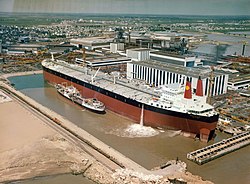
The world's longest ships are listed according to their overall length (LOA), which is the maximum length of the vessel measured between the extreme points in fore and aft. In addition, the ships' deadweight tonnage (DWT) and/or gross tonnage (GT) are presented as they are often used to describe the size of a vessel.
Contents
The ships are listed by type. Only ship types for which there exist a ship longer than 300 metres (1,000 ft) are included. For each type, the list includes current record-holders either as individual ships, ship classes or standard designs, up to four runner-ups, and all longer ships that have been scrapped.
The list does not include non-self-propelled floating structures such as the 488 m (1,601 ft) long Prelude FLNG. [1]




















